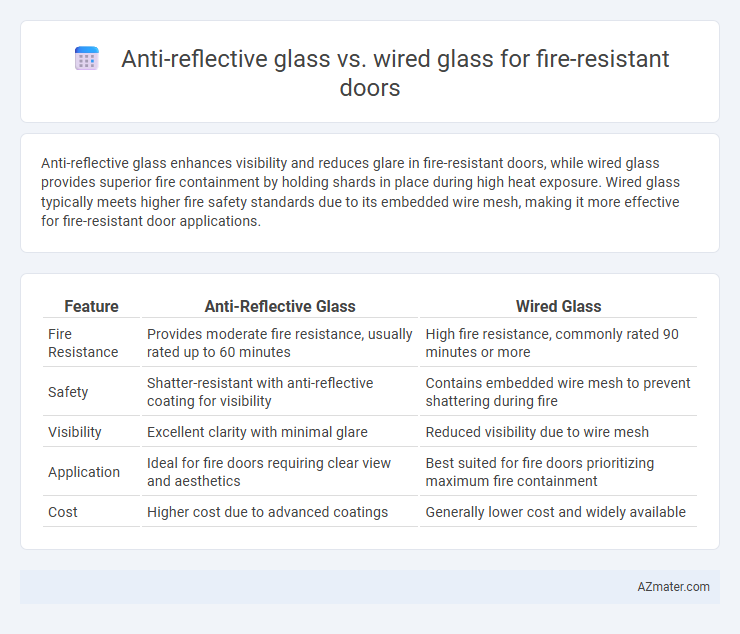Anti-reflective glass enhances visibility and reduces glare in fire-resistant doors, while wired glass provides superior fire containment by holding shards in place during high heat exposure. Wired glass typically meets higher fire safety standards due to its embedded wire mesh, making it more effective for fire-resistant door applications.
Table of Comparison
| Feature | Anti-Reflective Glass | Wired Glass |
|---|---|---|
| Fire Resistance | Provides moderate fire resistance, usually rated up to 60 minutes | High fire resistance, commonly rated 90 minutes or more |
| Safety | Shatter-resistant with anti-reflective coating for visibility | Contains embedded wire mesh to prevent shattering during fire |
| Visibility | Excellent clarity with minimal glare | Reduced visibility due to wire mesh |
| Application | Ideal for fire doors requiring clear view and aesthetics | Best suited for fire doors prioritizing maximum fire containment |
| Cost | Higher cost due to advanced coatings | Generally lower cost and widely available |
Introduction to Fire-Resistant Doors
Fire-resistant doors are essential safety components designed to prevent the spread of fire and smoke between compartments. Anti-reflective glass in fire-resistant doors improves visibility and light transmission while maintaining fire protection standards. Wired glass offers structural reinforcement through embedded metal mesh, enhancing fire resistance and preventing glass shattering under heat exposure.
What Is Anti-Reflective Glass?
Anti-reflective glass is specially treated to minimize glare and reflections, enhancing visibility and transparency in fire-resistant doors. This type of glass improves safety by allowing clear observation of fire conditions without distortion, unlike wired glass which contains embedded mesh for structural integrity. Its optical clarity combined with fire-resistant properties makes anti-reflective glass ideal for environments requiring both safety and clear visibility.
Understanding Wired Glass
Wired glass is a fire-resistant glass embedded with a metal wire mesh that helps maintain glass integrity during fire exposure by preventing shattering. Unlike anti-reflective glass, which primarily reduces glare and improves visibility, wired glass offers enhanced safety and fire containment by resisting heat and blocking flames. Its robust construction makes wired glass a preferred choice in fire-rated doors where both visibility and fire protection are critical.
Fire Safety Performance: Anti-Reflective vs Wired Glass
Anti-reflective glass for fire-resistant doors offers enhanced visibility without compromising fire safety, maintaining structural integrity under high temperatures up to 760degC for up to 60 minutes. Wired glass contains embedded wire mesh that prevents shattering and maintains barrier integrity during fire exposure but may impair visibility and reduce thermal resistance, typically rated for 45 to 90 minutes. Fire safety performance comparisons highlight anti-reflective glass's superior clarity and adequate fire resistance, while wired glass prioritizes mechanical stability and fire containment.
Impact Resistance and Durability
Anti-reflective glass offers enhanced visibility and reduces glare while providing moderate impact resistance, suitable for fire-resistant doors that prioritize clarity and safety. Wired glass excels in durability and impact resistance due to its embedded wire mesh, maintaining structural integrity under extreme heat and preventing glass shattering during fire incidents. For fire-resistant doors, wired glass typically delivers superior impact resistance and durability compared to anti-reflective glass, making it ideal for high-risk environments requiring stringent fire safety compliance.
Clarity and Aesthetics Comparison
Anti-reflective glass offers superior clarity and minimal glare, enhancing visibility and aesthetic appeal in fire-resistant doors compared to wired glass, which can appear cloudier due to embedded wire mesh. Wired glass provides a traditional industrial look but often compromises transparency and design elegance, making it less suitable for modern architectural applications prioritizing clear sightlines. The choice between these materials directly impacts the door's visual appeal and the ability to maintain safety standards without sacrificing design quality.
Applications in Modern Architecture
Anti-reflective glass enhances visibility and aesthetic appeal in fire-resistant doors, making it ideal for high-end commercial and residential buildings where natural light and clear sightlines are critical. Wired glass, known for its embedded metal mesh, provides superior structural integrity and fire containment, favored in industrial and institutional settings requiring stringent safety codes. Modern architecture leverages anti-reflective glass for sleek, transparent designs, while wired glass is preferred in areas demanding robust fire protection and security.
Cost Considerations and Installation
Anti-reflective glass for fire-resistant doors offers a higher upfront cost due to advanced coatings and manufacturing processes, while wired glass is generally more affordable and widely available. Installation of anti-reflective glass requires careful handling and precise fitting to maintain clarity and fire resistance, often leading to higher labor expenses; wired glass installation is simpler and faster, reducing overall labor costs. Choosing between the two depends on balancing budget constraints with aesthetic needs and long-term durability in fire safety applications.
Maintenance and Longevity
Anti-reflective glass in fire-resistant doors offers reduced glare and easier cleaning, resulting in lower maintenance efforts compared to wired glass, which often accumulates dirt in its mesh and requires specialized care. Wired glass, while traditionally valued for its fire resistance and structural integrity, is prone to corrosion of the embedded wire mesh over time, potentially reducing its longevity without regular inspection and upkeep. In contrast, anti-reflective glass typically features advanced coatings and treatments that enhance durability and extend the service life of the door under various environmental conditions.
Choosing the Right Glass for Fire-Resistant Doors
Anti-reflective glass offers enhanced visibility and reduced glare, making it ideal for fire-resistant doors in commercial buildings where clear sightlines are essential for safety. Wired glass provides superior fire resistance and structural integrity, protecting against heat and flames while minimizing the risk of glass breakage during fire incidents. Selecting the appropriate glass involves balancing fire rating requirements, visibility needs, and building codes to ensure optimal safety and performance in fire-resistant door applications.

Infographic: Anti-reflective glass vs Wired glass for Fire-resistant door
 azmater.com
azmater.com